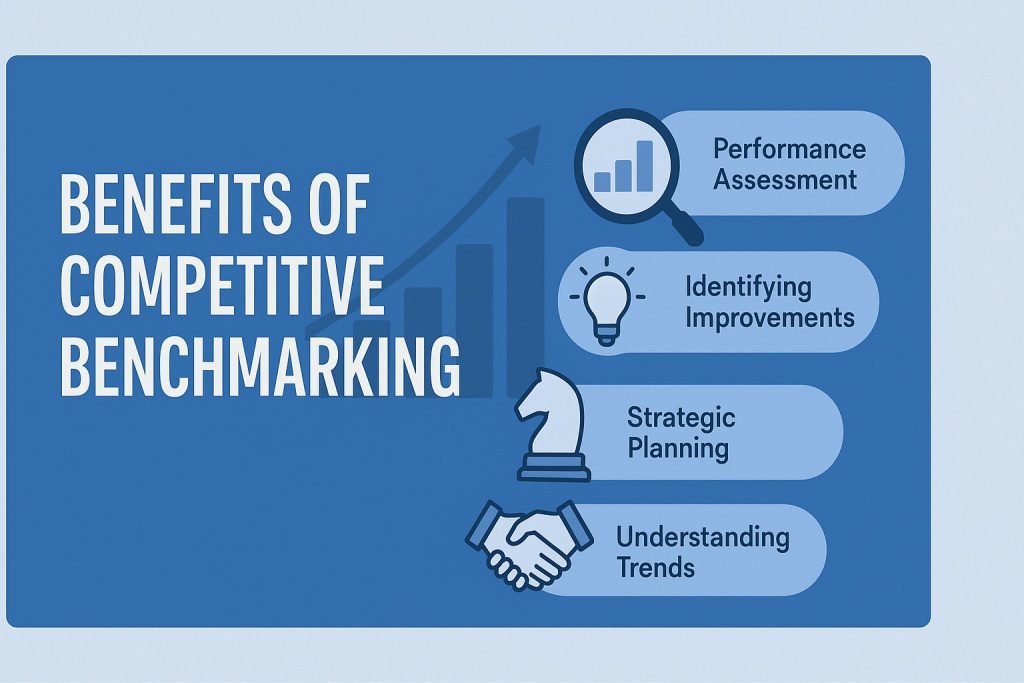Staying ahead in any industry requires more than just a great product or service. It demands a deep understanding of your market, your competitors, and your own performance. This is where competitive benchmarking comes in. It’s a powerful strategic tool that allows you to measure your business against the best in the industry, uncovering opportunities for business growth and innovation.
By looking outside your own walls, you can set realistic brand goals, refine your processes, and ultimately deliver more value to your customers.

This guide will explore the significant benefits of competitive benchmarking. We will define what it is, examine how it drives improvement, and provide a clear roadmap for implementing it within your own organization.
What is Competitive Benchmarking?
Competitive benchmarking is the systematic process of comparing your company’s processes, products, and performance metrics against those of your direct competitors and industry leaders. The goal isn’t simply to copy what others are doing. Instead, it’s about identifying “best practices” that have led to superior performance elsewhere and then adapting those practices to fit your own unique business context.
This process moves beyond a surface-level competitor analysis, which might only look at marketing tactics or pricing. Benchmarking dives deeper into the how and why behind a competitor’s success. It involves measuring specific key performance indicators (KPIs) across various business functions, including:
- Operations: Production costs, supply chain efficiency, quality control.
- Marketing: Customer acquisition cost, brand awareness, social media engagement.
- Sales: Sales cycle length, conversion rates, average deal size.
- Customer Service: Response times, customer satisfaction scores (CSAT), net promoter score (NPS).
- Product Development: Time to market, feature adoption rates, R&D investment.
By gathering and analyzing this data, you gain an objective, external perspective on your own performance, which is crucial for making informed strategic decisions.
Key Benefits of Competitive Benchmarking
Integrating competitive benchmarking into your strategy can transform your business. It provides a clear, data-driven path to improvement and helps you navigate the market with greater confidence.
Let’s explore the primary benefits in detail.
Identify and Understand Industry Standards
Without an external reference point, it’s difficult to know if your performance is good, average, or lagging. You might think your 5% conversion rate is excellent, but if the industry average is 10%, you have a significant opportunity for improvement. Benchmarking establishes a baseline for performance.
- Setting Realistic Goals: It helps you set achievable yet ambitious targets based on proven results in your industry. Instead of guessing what’s possible, you can aim for standards that top performers are already meeting.
- Contextualizing Performance: Your internal metrics gain new meaning when compared to others. A 10% year-over-year growth in website traffic might seem modest, but if the industry average is only 2%, it highlights the success of your marketing efforts.
- Avoiding Complacency: Success can breed complacency. Benchmarking keeps you on your toes by showing you where competitors are excelling, preventing you from falling behind even when your business is performing well.
Drive Performance Improvement and Innovation
One of the most powerful benefits of competitive benchmarking is its ability to highlight specific areas for improvement. By seeing how others achieve superior results, you can identify inefficiencies in your own processes and discover innovative solutions.
- Process Optimization: Suppose a competitor has a significantly shorter production cycle. Benchmarking their process could reveal a more efficient supply chain management technique or a different manufacturing technology that you could adopt. This insight leads directly to cost savings and faster delivery times.
- Sparking Innovation: Benchmarking is not about imitation; it’s about inspiration. Learning how a company in a different industry handles customer support might spark a completely new idea for your own customer service model. This cross-industry perspective can be a powerful catalyst for breakthrough innovations.
- Prioritizing Initiatives: With limited resources, it’s essential to focus on initiatives that will have the most significant impact. Benchmarking helps you identify the performance gaps with the widest margin, allowing you to prioritize projects that will deliver the best return on investment.
Gain a Deeper Understanding of Market Trends
Markets are constantly evolving. New technologies emerge, customer expectations shift, and new competitors enter the scene. Competitive benchmarking acts as an early warning system, helping you spot and adapt to these changes before they disrupt your business.
- Anticipating Market Shifts: By monitoring the strategies of industry leaders, you can see which new technologies they are adopting or which new markets they are entering. This can signal a broader shift in the industry that you need to prepare for.
- Informing Product Development: Are competitors adding specific features to their products? Is there a growing demand for sustainable or ethically sourced goods? Benchmarking helps you answer these questions, ensuring your product roadmap aligns with current and future market demands.
- Refining Your Value Proposition: Understanding how your competitors position themselves helps you clarify your own unique value proposition. You can identify gaps in the market that your competitors are not serving and tailor your messaging to highlight what makes your offering different and better.
Enhance Customer Satisfaction and Loyalty
Ultimately, business success hinges on your ability to meet and exceed customer expectations. Competitive benchmarking provides invaluable insights into what it takes to win over and retain customers in your industry.
- Improving the Customer Experience: By benchmarking customer service metrics like response times, resolution rates, and satisfaction scores, you can identify where your support process falls short. If a competitor offers 24/7 chat support and you only offer email support during business hours, you’ve found a clear area to improve.
- Benchmarking Product Features: Are your customers leaving for a competitor’s product? Benchmarking their features and user experience can reveal what you’re missing. This allows you to make data-driven decisions about which features to add or improve to increase customer retention.
- Building a Stronger Brand: Customer loyalty is built on trust and a consistently positive experience. By striving to meet and exceed the standards set by the best in your industry, you build a reputation for quality and reliability, which is a key driver of long-term customer loyalty.
Real-World Examples of Competitive Benchmarking Success
Theory is one thing, but seeing competitive benchmarking in action highlights its true power. Let’s look at how two well-known companies used this strategy to achieve remarkable results.
Case Study: Ford Motor Company
In the early 1980s, the American automotive industry was struggling against more efficient Japanese manufacturers. Ford was facing significant financial losses and needed a way to turn things around. The company turned to competitive benchmarking, sending teams to Japan to study the operations of companies like Toyota.
They discovered that Japanese automakers were far more efficient in areas like inventory management, quality control, and production processes. For example, Ford learned about the “just-in-time” inventory system, which dramatically reduces the costs associated with storing large quantities of parts.
By adapting these best practices to their own operations, Ford was able to cut costs, improve vehicle quality, and regain its competitive edge. The Ford Taurus, a product of this new way of thinking, became one of the best-selling cars in America. This is a classic example of how benchmarking can drive a complete corporate turnaround.
Case Study: Starbucks
Starbucks is renowned for its customer experience, but it wasn’t always the undisputed leader. To maintain its position, Starbucks continuously benchmarks itself not only against other coffee shops but also against leaders in customer service from other industries, like luxury hotels and high-end retailers.
The company studies how these businesses create welcoming environments, train their staff to provide exceptional service, and build customer loyalty. This has influenced everything from the design of their stores to the way baristas are trained to interact with customers.
Furthermore, Starbucks benchmarked the operational efficiency of fast-food chains like McDonald’s to improve the speed of its service without sacrificing quality. By looking at how McDonald’s optimized its drive-thru process, Starbucks was able to find ways to serve more customers more quickly, especially during peak morning hours. This blend of benchmarking hospitality and efficiency has been a key ingredient in Starbucks’ enduring success.
How to Implement Competitive Benchmarking Effectively
A successful benchmarking project requires a structured approach. Following a clear process ensures that you collect the right data, derive meaningful insights, and translate those insights into action. Here are the essential steps to get started.
Step 1: Plan Your Benchmarking Project
The first step is to decide what you want to benchmark. You can’t measure everything, so it’s crucial to focus on the areas that are most critical to your business success.
- Identify Key Processes to Benchmark: Start by identifying the areas where you suspect your performance could be improved. This could be anything from your customer onboarding process to your supply chain logistics.
- Define Specific Metrics (KPIs): Once you’ve chosen a process, define the specific KPIs you will use to measure performance. For example, if you’re benchmarking customer service, your KPIs might include average response time, first-contact resolution rate, and customer satisfaction (CSAT) score.
- Form a Benchmarking Team: Assemble a cross-functional team with representatives from different departments. This ensures you have a variety of perspectives and the necessary expertise to analyze the data you collect.
Step 2: Identify Your Benchmarking Partners
Next, you need to decide who you will measure yourself against. There are several types of benchmarking partners you can choose from.
- Direct Competitors: These are the companies that offer similar products or services to the same target audience. This is the most common type of benchmarking.
- Industry Leaders: These are the top-performing companies in your industry, even if they are not direct competitors. They set the standard for excellence.
- Functional Leaders: These are companies from different industries that are known for their world-class performance in a specific function. For example, if you want to improve your logistics, you might benchmark against Amazon or FedEx.
Step 3: Collect and Analyze the Data
This is the research phase of the project. Your goal is to gather quantitative and qualitative data on the performance of your benchmarking partners.
- Data Collection Methods: Data can be collected from various sources. Publicly available information, such as annual reports, press releases, and industry publications, is a great starting point. You can also use third-party research firms, customer surveys, and specialized analytics tools to gather competitive intelligence.
- Normalize the Data: It’s important to ensure you’re comparing apples to apples. You may need to adjust the data to account for differences in company size, market focus, or accounting methods. This process, known as data normalization, is critical for accurate analysis.
- Identify Performance Gaps: Once you have clean data, compare your performance against your benchmarking partners. The difference between your performance and theirs is the “performance gap.” Analyze the root causes of these gaps. What are the best-in-class companies doing differently in terms of processes, technology, or strategy?
Step 4: Implement Changes and Monitor Progress
The insights you gain from your analysis are only valuable if you act on them. This final step is about turning your findings into a concrete action plan.
- Develop an Action Plan: Based on your analysis, develop a detailed plan for implementing changes. This plan should include specific goals, timelines, and a clear allocation of responsibilities.
- Communicate and Secure Buy-In: Share your findings and your action plan with key stakeholders across the organization. It’s essential to explain the “why” behind the proposed changes to get everyone on board.
- Monitor and Continuously Improve: Benchmarking is not a one-time project. It’s an ongoing cycle of measurement, analysis, and improvement. Continuously monitor your KPIs to track the impact of your changes and regularly revisit your benchmarks to ensure you’re keeping pace with the industry.
Conclusion: Make Benchmarking Your Competitive Advantage
In a competitive business landscape, standing still is not an option. Competitive benchmarking provides the roadmap you need to navigate the market with clarity and purpose. By systematically measuring your performance against the best in the business, you can uncover hidden opportunities, drive meaningful improvements, and build a more resilient and successful organization.
The benefits are clear: from setting more intelligent goals and optimizing your operations to understanding marketing business trends and delighting your customers. It’s a strategic exercise that moves you from guesswork to data-driven decision-making. By embracing competitive benchmarking as a continuous process, you empower your business to not just compete, but to lead.


